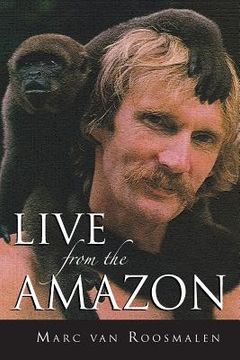Reseña del libro "Live from the Amazon (en Inglés)"
Not many biologists can claim to know the Amazon as well as Marc van Roosmalen, or to be more concerned about its future, so it's an important addition to Amazon biology and conservation to have Van Roosmalen's uniquely personal account of his decades of Amazon research. "Live from the Amazon" successfully blends personal narrative and scientific data. Chapter 1 sets the tone of the book - describing as he does being "humbled by nature". This includes a self-deprecating account of one of his earliest sorties into the rainforest with the realization and rising sense of panic that he was lost - in the Amazon. Or later, almost literally bumping into a jaguar and recognizing that if you don't behave like prey you probably won't be treated like prey. Early on, to become a primatologist Van Roosmalen took a two-year hiatus to become a botanist, publishing the "Illustrated Guide to the Fruits of the Flora of Suriname" - the first guide of its kind to the area. Just so that he could identify what his monkeys were eating. With this new expertise he was able to gather ground-breaking information on the ecology of a species of spider monkey. Even with some lengthy narrative detailing a day in the life of a group spider monkeys in chapter 2, for example, it's difficult not to be swept up in his accounts and imagining for instance what it must be like to track one of these groups through miles and miles of rainforest and to survive on the fruits that monkeys themselves survived. These accounts, and others like them, are great examples of how demanding field work is actually done - describing the nuts and bolts of a process that eventually leads to polished publications. The development of the details of his "fruit syndromes" in chapter 3 - classifying the all-important seed dispersal strategies of rainforest trees - could only come about from a wealth of first-hand experience in the field, and indeed a rounded knowledge of how the rainforest works. But the knowledge was a hard one. In the same self-deprecating manner and with hubris biting back, Van Roosmalen describes a near fatal mistake in eating a fruit based on a misjudged observation of exactly how his spider monkeys were eating the fruit. Chapter 4 covers the fascinating geological and hydrological history of the Amazon Basin (it used to drain mostly to the west, not to the east) and the resulting aquatic species that adapted from marine to freshwater conditions - and the famous contrasting Amazon water types and the differing ecologies they give rise to in the Basin's vast flood plains. Van Roosmalen is perhaps best well known for his discovery of new species of Amazon monkeys (as well as many other Amazon animal and plant species new to science; the list isn't short - you should also visit his website www.marcvanroosmalen.com). In chapter 5 there is the absolutely remarkable detective story of finding the black-crowned dwarf marmoset, a new primate genus and the second-smallest species of monkey in the world. And in finding the dwarf marmoset he finds at least as great a prize: a biologically "lost world" that not only houses the dwarf marmoset but other remarkable new species, many of them not dwarf at all. It's alarming to learn that this irreplaceable area is currently under threat. And there's a lot more. Wherever he focuses his attention among the wide range of topics he covers, Van Roosmalen is great at seeing both small and large-scale patterns in the workings of the Amazon Basin, and generating explanations for them. He has done the work himself all alone - in true fashion of the 19th century naturalists that he frequently nods in the direction of. With many examples of Amazon biology for the first time in print, "Live from the Amazon" is a rich resource for graduate students looking for a project and an important addition to the library of anyone who cares about the ecology, and future, of the greatest rainforest this world has left. Nig

